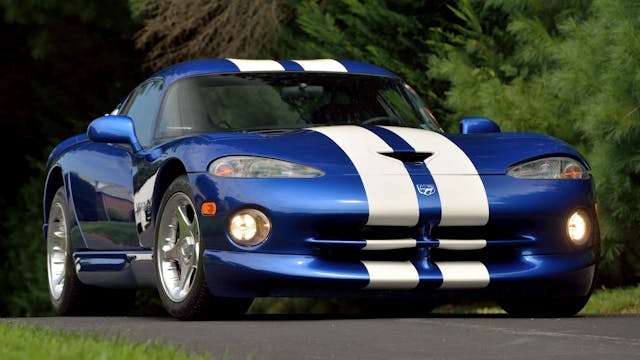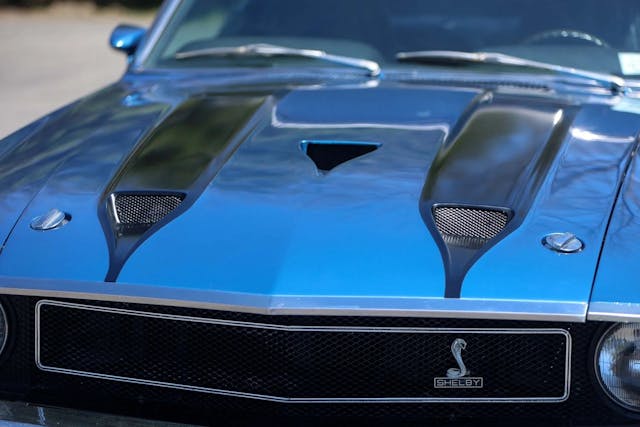The 10 coolest cars with NACA ducts
At the beginning of World War I, just 11 years after the Wright brothers’ first flight, the United States was lagging behind Europe in aviation technology. In an effort to catch up, Congress formed the National Advisory Committee for Aeronautics (NACA) on March 3, 1915. The organization, which would become the National Aeronautics and Space Administration (NASA) in 1958, reported directly to the president and began to develop wind tunnels to study streamlining and aerodynamics. The research rapidly increased the range and speed of American aircraft.
In the 1930s and 1940s NACA developed an airfoil design for wings and propellers that can be found on many important WWII aircraft including the P-51 Mustang. NACA contributed greatly to the first supersonic flight in 1947, achieved by Chuck Yeager at the stick of the X-1 experimental airplane, and thereafter turned its attention to missile technology and manned space flight.
Many of the organization’s aerodynamic achievements began to influence the design of automobiles, and the NACA ducts appeared on cars in the mid-1950s.
“In 1951 the original NACA report on it was declassified, and the design of the duct became public information, available for use by anyone,” wrote Motor Sport magazine in 2000. “Racing cars were an obvious application, but it wasn’t until 1956 and the emergence of Frank Costin’s redesigned Vanwall that someone had the nous to exploit it.”
That same year, small recessed scoops also appeared on the quarter panels of Ford’s Continental Mark II. They’re not exactly NACA ducts, but they’re close.
Developed in the agency’s wind tunnels, the low-drag air inlet submerged into the bodywork with curved sides and a blunt, squared-off end is still commonly found on race cars and high-performance production cars today. The NACA duct has become an iconic statement of speed.
Presented in chronological order, here are our picks for the 10 coolest high-performance street cars with NACA ducts.
1969–70 Ford Mustang Shelby GT350/GT500

Carroll Shelby didn’t have much to do with the Shelby Mustang by 1969; however, the car’s distinctive fiberglass hood with three NACA ducts assures both the GT350 and the GT500’s places on this list. The center scoop feeds the carburetor, while the two on the sides help draw hot air out of the engine compartment. The hot air then exits through two open vents closer to the cowl.
The hood design remained the same over the two model years, though the 1970 cars were actually leftover 1969 models and received black hood stripes for visual distinction.
1973 Pontiac GTO

This is the only muscle car from General Motors ever to wear NACA ducts. Two appeared in the center of its hood—and they were fakes. They did not feed the carburetor as originally intended but were instead blocked off by the factory. Allegedly, Pontiac did offer the rest of the prototyped induction system through dealers and about 10 cars with functional scoops were built. One is said to exist today.
Regardless, the muscle-car craze was quickly winding down by 1973, and the redesigned Pontiac GTO went over with a thud. The body style lasted just one year and Pontiac only sold just 4806, making it the worst-selling GTO of all time.
1974–90 Lamborghini Countach

Officially, we haven’t taken any measurements, but the award for the largest NACA ducts has to go to the Lamborghini Countach, which first appeared at the 1971 Geneva Auto Show and reached production three years later.
The mid-engine supercar features a single and sizable NACA duct on each side, beginning on each door and covering most of the quarter panels, feeding its massive radiators to keep its big V-12 engine cool. Production lasted until 1990 with nearly 2000 produced. Its successors, the Diablo, the Murciélago, and the Aventador, which just finished an 11-year production run, do not feature NACA ducts.
1980–86 Renault R5 Turbo

A homologation special for Group 4 rally competition, this little Renault is basically a Le Car with radically flared hips, rear-wheel drive, and a 158-hp, turbocharged 1.4-liter four-cylinder engine mounted in place of its back seat. About 5000 were built over six years. Two iterations, the Turbo 1 and the Turbo 2, each have a single, small NACA duct atop the left rear quarter panel.
The R5 Turbo was styled by Marcello Gandini at Bertone, who designed the Countach and penned many other machines featuring NACA ducts, including the Alfa Romeo Montreal and the Lamborghini Espada.
1987–96 Ruf Yellowbird

In 1987, Road & Track declared the Ruf CTR the world’s fastest production street car. It received its nickname “Yellowbird” during testing that year when it achieved a terminal velocity of 211 mph and accelerated to 60 mph in 3.6 seconds. It was powered by a twin-turbo, 3.4-liter flat six said to make 463 hp. The car cost $223,000. According to Ruf, 29 examples were built and 20 to 30 more were created from customer 911s.
If you haven’t seen the footage of this car drifting the Nürburgring, check it out on YouTube immediately. Look for its two large NACA ducts, one atop each rear wheelwell flare.
1987 Callaway Corvette

For many Gen Xers, the first car they remember with NACA ducts is the 1987 twin-turbo Callaway Corvette. Three years before the DOHC ZR-1, the most powerful Corvette was created with option code RPO B2K. It sent your new Corvette to Callaway Engineering in Connecticut, where its 5.7-liter V-8 was pumped up from with a pair of turbochargers and intercoolers.
Even sweeter were the two NACA ducts Callaway carved into Corvette’s hood. Sadly, however, they would last only one year. According to Callaway, 445 Corvettes were ordered with the RPO B2K option over the four-year run, so only 123 coupes and 65 convertibles featured the NACA duct hood.
1987–92 Ferrari F40

This was the last Ferrari personally signed off by Enzo himself. Built to commemorate the company’s 40th birthday, the successor to the 288 GTO featured a mid-mounted, twin-turbo 2.9-liter V-8 and two small NACA ducts in its front decklid.
It was the quickest, fastest, most expensive, and most powerful Ferrari of all time, with over 470 hp and a body made of aluminum, carbon fiber, and Kevlar. To save weight, the interior was race-car-raw, without door handles, glovebox, carpet, or sound system. The F40 was a stark contrast to its rival at the time, the all-wheel-drive Porsche 959. Just 1311 F40s were built, with a top speed just shy of 200 mph.
1996–2002/2013–17 Dodge Viper

This one needs a little more explanation. The original Dodge Viper, which went on sale in 1992, did not have a NACA duct in its hood feeding fresh air to its V-10 engine. In 1996, however, Dodge gave the sports car a bit of a facelift and introduced a coupe version called the Viper GTS.
The GTS was the first Viper with the large NACA duct in its hood, but Viper roadsters remained scoopless. An all-new Viper coupe and convertible arrived in 2003. Although a scoop remained in the hood of each style, it was not a NACA duct. This arrangement remained the lay of Viper land through 2010. The model left us for a little while, finally returning for a brief four years in 2013 as a coupe only … happily, with an aerodynamic NACA duct.
2008–15 Mitsubishi Evo X

This is the only four-door sedan on this list—the 10th and final generation of the Mitsubishi Evolution, a turbocharged and all-wheel-drive rally car inspired by the rival of the Subaru WRX STI. Known for its flared flanks and oversized rear spoiler, the last of the Evos also wore a single NACA duct in its hood. Although it wasn’t functional on the street-going model, the duct was put into use on Evos in rally competition. These cars were powered by a turbocharged, 16-valve 2.0-liter four-cylinder that made 291 hp and 303, in the Final Edition.
2009–2020 Nissan GT-R

NACA ducts did not appear on the R32, R33, or R34 versions of Nissan’s Skyline GT-R. However, they’ve been an important part of the aerodynamics and performance of the R35 GT-R, which was launched in 2009 and remains in production 14 years later. There have always been two on the supercar’s hood, and on 2019’s 600 hp GT-R NISMO, they were incorporated into the composite structure of the panel. They’ve never directed air into its boosted 3.8-liter V-6; instead, they duct cool outside air onto the engine’s twin turbochargers for cooling.
***
Check out the Hagerty Media homepage so you don’t miss a single story, or better yet, bookmark it. To get our best stories delivered right to your inbox, subscribe to our newsletters.



Ferrari Dino.s (206, 246) should lead the list given its age (1967), style and functionality.
I might be mistaken but I consider the hood scoop on the 1970 Plymouth Cuda AAR a NACA style one.
Similar but not the same. NACA ducts by design are flat and not raised above the surface. The AAR Cuda had a raised dome.
Nice list, but I think the 1984-86 Mustang SVO has one of the best of the NACA ducts I’ve seen, which directly fed the turbo intercooler. It’s gorgeous, and I love how it was slightly offset to the right…
My first thought as well!
Once again, similar but not the same. NACA ducts by design are flat and not raised above the surface. The SVO Mustang had a raised dome.
Now for the rest of the story.The 1st time many saw a NACA duct was on the North American YF-93 fighter from 1950s.
Basically, it was an enlarged North American F-86 redesigned for long range escort duties. It was to feature heavy 20mm cannon armament in the nose where F-86s had its air intake.
So to feed its hungry turbojet, NACA ducts were placed on either side of the fuselage.
Do an internet search for a photi,you’ll be impressed.
They didn’t quite provide enough air, so later, a common “cheek” inlet was used.
On later jets, including airliners, small ducts were used for various intakes cooling accessories and providing cabin air.
I believe my 2006 Saab 9-2X Aero had functional ducts.
Where? The hood. That’s just one and not the same. NACA ducts by design are recessed below the body line, not raised above the surface. The hood of your 9-2X Aero has a raised dome.
Re: The Renault R5 Turbo — Per the description, there is “a single, small NACA duct atop the left rear quarter panel” — it is not the large intake pictured on the right rear quarter panel. Do you have a (left side) photo with the NACA duct, and what function did it perform?
On minor correction: the first car with NACA ducts that we Gen X people remember is, in fact, the Countach. Its posters appeared on many a bedroom wall long before the Callaway Corvette came along. We do, however, remember just how insane Callaway made the “ordinary” Corvette become!
Yes, but Lamborghini had NACA ducts long before the Countach. Check out the Espada!
“Regardless, the muscle-car craze was quickly winding down by 1973, and the redesigned Pontiac GTO went over with a thud. The body style lasted just one year and Pontiac only sold just 4806, making it the worst-selling GTO of all time.”
Or you could say, the 1973 redesigned Pontiac GTO is the most rare with only 4806 built.
Personally, I like the colonnade-style A-body Pontiacs. The ’73 GTO, the 1973-75 Grand Am and the 1977 Can Am are some of my favorites.
The last of the “original run” GTOs was the 1974 X-body based (Nova/Ventura) coupe and hatchback. Instead of having forward facing scoops it had a Trans Am style shaker hood. While much maligned today, it actually outsold the previous 1972 and 1973 GTOs almost combined:
1972 = 5,807
1973 = 4806
1974 = 7,058
And it was back to being a smaller platform car, sort of like the original 64. Yes I know, the 64 was technically an A body, but my point is the A body had grown quite large after 67, and the original intent was to stuff a big engine from the large car platform into a smaller intermediate body car. The Ventura GTO was actually closer to that original intent, though it had a smaller displacement. And who can argue that it’s sister car, the Nova SS were not cool, so I think it was the right car to be the new GTO, at the time. I also think it was smart marketing to capitalize on the Trans Am’s popularity by using the cool exhaust tips and reverse shaker hood. The more I think about it, the more I liked those 74 Goats.
Wasn’t the early cowl plenum induction offered on 1967/1968 Z/28’s and the earlier Z11 Chevelle SS kind of a subtle offering? In some ways, it was like the 1973 GTO, blocked off at the factory.
Some of these systems were found more effective than forward facing scoops as this area. In the Trans Am series, the under hood cold air systems were outlawed in 1969. Generally, in most forms of racing, they try to even out the field.
No. While they weren’t all sealed off to the carb, they were all open and functional.
The earliest Chevy Cowl Induction didn’t even have a raised hood. It used the original vents in the cowl area at the base of the hood that were part of the HVAC intake and the “flush and dry” rocker panel ventilation system. The air cleaner was then sealed to a hole cut in the firewall into that area.
Google: “1967 Camaro Z28 cowl plenum air cleaner”
Never checked to see if mine was sealed off to the heating / vent system. That would probably a minor leak at speed. The plastic was too hard – duct tape was needed as they cracked almost right away when you pushed the car.
It has already been mentioned a few times in the comments, but what about the 71-73 Mustangs???? Yes, I own a 72 with 2 Naca scoops in the hood. They look better on the 71-73 cars than they do on the 69 Shelby.
Similar but not the same. NACA ducts by design are recessed below the surface and not raised above the surface. The ones on 1971-73 Mustangs are of a different shape and raised above the hood.
The 71-73 are flush with the center surface of the hood, and slightly raised compared to the outside edge. 50% right / 50% wrong?
Come on guys – do not forgot the Ferrari 512bb !!
I had the opportunity, some years ago, to have lunch with Alois Ruf. he told me that the purpose of the NACA ducts on Yellow Bird was to provide additional ventilation to the engine compartment. At some point they measured the flow through them and were surprised to find that it was going in the reverse direction, so they had to rethink the ventilation scheme in future designs. He mentioned it to make the point, which all of us who deal with objects and devices know, that sometimes even the simplest things do not work the way one would expect.
Missed the ’72 TVR 2500M
Lamborghini Espada and Jarama – very functional cabin air intakes on the hood.
Good call!
I believe all 2500Ms had Naca scoops. My 74 does
And the 1970 TVR Vixen S2,
F40 followed by the Viper would be my favorite on the list.
I don’t care for the mesh on the Mustang’s ducts.
Whenever you do a list like this, I always try to see how many I can come up with before actually opening and reading the article. First to mind was the Countach. Next, I thought of the ’69/’70 Shelby (the first car I ever saw with NACA ducts). After that, I thought about the Montreal. So I got three of your ten – not too shabby. I see multiple suggestions here of the ’71-3 Mustang. I would not really consider that hood as having NACA ducts. In my mind, NACAs are cut into a flat surface, with all the intake happening because of the vortices / swirls formed by air moving over the slanted leading edges. The long ‘Stangs in question feature a bulged hood with semi-NACA duct shapes is cut into of the leading edge. I’m certainly no expert, but in my mind, that is really more of a somewhat NACA-shaped hood scoop… You know – air goes in because it gets caught in a hole… Have to admit that I did not realize the Montreal’s was non-functional. But then again, I have only ever seen one example. Another great article. (except I don’t think I would consider that particular GTO a cool car…) Thanks!
I was reading your comment and nodding my head, “yes, this guy gets it” … until your last sentence. Come on man, the ’73 GTO wasn’t that bad. 😉